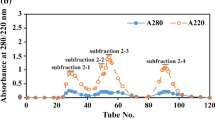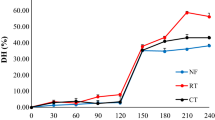Abstract
The changes of protein digestibility, the peptides in the digestive juice and angiotensin I converting enzyme (ACE) inhibitory activity after heating of oysters were investigated. The digestibility of raw oysters was 71.1%, and that of oysters heated at 100 °C was 67.9%. A total of 169 and 370 peptides were identified from the digestion of raw oysters and heated oysters, respectively. According to UPLC-Q-TOF-MS spectra, the peptides with a molecular weight below 2000 Da accounted for 87.6% of the total peptides of raw oysters and 94% of heated oysters. Testing the ACE inhibitory activity in vitro, the IC50 values of raw oyster and cooked oyster were 6.77 μg/mL and 3.34 μg/mL, respectively. Taken together, the results showed that heated oysters could produce more active peptides and provide ACE inhibitory activity.






Similar content being viewed by others
References
Asha KK, Kumari KRR, Kumar KA, Chatterjee NS, Anandan R, Mathew S. Sequence determination of an antioxidant peptide obtained by enzymatic hydrolysis of oyster Crassostrea madrasensis (Preston). Int. J. Pept. Res. Ther. 22: 421-433 (2016)
Cai B, Pan J, Wu Y, Peng W, Sun H. Immune functional impacts of oyster peptide-based enteral nutrition formula (OPENF) on mice: a pilot study. Chin. J. Oceanol. Limn. 31: 813-820 (2013)
Carlson-Bremer D, Norton TM, Sanders FJ, Winn B, Spinks M, Glatt BA, Mazzaro L, Jodice P, Chen TC, Dierenfeld ES. Circulating fat-soluble vitamin concentrations and nutrient composition of aquatic prey eaten by American oystercatchers (Haematopus palliatus palliatus) in the Southeastern United States. J. Avian Med. Surg. 28: 216-224 (2014)
Carvalho AFU, de Sousa NM, Farias DF, da Rocha-Bezerra LCB, da Silva RMP, Viana MP, Gouveia ST, Sampaio SS, de Sousa MBD, de Lima GPG. Nutritional ranking of 30 Brazilian genotypes of cowpeas including determination of antioxidant capacity and vitamins. J. Food Compos. Anal. 26: 81-88 (2012)
Chen H, Shi P, Fan F, Tu M, Xu Z, Xu X, Du M. Complementation of UPLC-Q-TOF-MS and CESI-Q-TOF-MS on identification and determination of peptides from bovine lactoferrin. J. Chromatogr. B. 1084: 150-157 (2018)
Deb-Choudhury S, Haines S, Harland D, Clerens S, Van KC, Dyer J. Effect of cooking on meat proteins: mapping hydrothermal protein modification as a potential indicator of bioavailability. J. Agr. Food Chem. 62: 8187-8196 (2014)
Escudero E, Mora L, Toldrá F. Stability of ACE inhibitory ham peptides against heat treatment and in vitro digestion. Food Chem. 161: 305-311 (2014)
Froelich B A, Noble R T. Vibrio bacteria in raw oysters: managing risks to human health. Philos. Trans. R. Soc. Lond. B Biol. Sci. 371: 20150209 (2016)
Fu J, Lin J, Zheng H, Chen Z, Tan A, Xie Y. Optimization of conditions for autolysis hydrolysis of Jinjiang oyster protein. Mod. Food Sci. Technol. 28:195-199 (2012)
Haberkorn H, Lambert C, Goïc NL, Moal J, Suquet M, Guéguen M, Sunila I, Soudant P. Effects of Alexandrium minutum exposure on nutrition-related processes and reproductive output in oysters Crassostrea gigas. Harmful Algae 9: 427-439 (2010)
Hu X, Wu H, Fan X, Liu Q. Immunomodulatory activity of glycosaminoglycans from Jinjiang oyster Crassostrea rivularis. Mod. Food Sci. Technol. 12: 16-24 (2014)
Kamath SD, Abdel Rahman AM, Komoda T, Lopata AL. Impact of heat processing on the detection of the major shellfish allergen tropomyosin in crustaceans and molluscs using specific monoclonal antibodies. Food Chem. 141: 4031-4039 (2013)
Kim S, Bang C, Kim A, Ha J, Choi Y, Choung S. Inhibitory effect of active peptide from oyster hydrolysate on Angiotensin-I Converting Enzyme (ACE). Planta Med. 79: 1665-1682 (2013)
Kitaoka C, Hosoe J, Hakamatsuka T, Araya K, Habara M, Ikezaki H, Hamada-Sato N, Shinagawa A, Yamamoto J, Kato-Yoshinaga Y. Taste component analysis of Pacific oysters cultured in Konagai, Nagasaki and taste evaluation using a taste-sensing system. Jpn. J. Food Chem. Saf. 23: 63-71 (2016)
Malgorzata T, Joost VN, Huub S. Food processing: the influence of the Maillard reaction on immunogenicity and allergenicity of food proteins. Nutrients 9: 835-852 (2017)
Martínez-Fernández E, Acosta-Salmón H, Southgate PC. The nutritional value of seven species of tropical microalgae for black-lip pearl oyster (Pinctada margaritifera L.) larvae. Aquaculture 257: 491-503 (2006)
Menezes EA, Oliveira AF, França CJ, Souza GB, Nogueira A. Bioaccessibility of Ca, Cu, Fe, Mg, Zn, and crude protein in beef, pork and chicken after thermal processing. Food Chem. 240: 75-83 (2017)
Mora L, Bolumar T, Heres A, Toldrá F. Effect of cooking and simulated gastrointestinal digestion on the activity of generated bioactive peptides in aged beef meat. Food Funct. 8: 4347-4355 (2017)
Nakamura A, Watanabe K, Ojima T, Ahn DH, Saeki H. Effect of Maillard reaction on allergenicity of scallop tropomyosin. J. Agric. Food Chem. 53: 7559-7564 (2005)
New CY, Kantilal HK, Tan MTH, Nakaguchi Y, Nishibuchi M, Son R. Consumption of raw oysters: a risk factor for Vibrio parahaemolyticus infection. Int. Food Res. J. 21: 2459-2472 (2014)
Njintang NY, Mbofung CMF, Waldron KW. In vitro protein digestibility and physicochemical properties of dry red bean (Phaseolus vulgaris) flour: effect of processing and incorporation of soybean and cowpea flour. J. Agric. Food Chem. 49: 2465-2471 (2001)
Padula D, Greenfield H, Cunningham J, Kiermeier A, Mcleod C. Australian seafood compositional profiles: a pilot study. Vitamin D and mercury content. Food Chem. 193: 106-111 (2015)
Park E, Song KB. Isolation of angiotensin converting enzyme inhibitors from pig blood. Agric. Chem. Biotechnol. 40: 39-42 (1997)
Qian Z, Jung W, Byun H, Kim S. Protective effect of an antioxidative peptide purified from gastrointestinal digests of oyster, Crassostrea gigas against free radical induced DNA damage. Bioresour. Technol. 99: 3365-3371 (2008)
Ren W, Li Y, Geng X, Wang S, Guo J. Isolation of angiotensin-converting enzyme inhibitor from enzymatic hydrolysate of hog bone collagen. Chin. Biochem. J. 12: 693-697 (1996)
Roskar R, Simoncic Z, Gartner A, Kmetec V. Stability of new potential ACE inhibitor in the aqueous solutions of different pH. J. Pharm. Biomed. Anal. 49: 295-303 (2009)
Singh TK, Øiseth SK, Lundin L, Day L. Influence of heat and shear induced protein aggregation on the in vitro digestion rate of whey proteins. Food Funct. 5: 2686-2698 (2014)
Tian L, Liu J, Ma L, Zhang L, Wang S,Yan E, Zhu H. Isolation and purification of antioxidant and ACE-inhibitory peptides from Yak (Bos grunniens) skin. J. Food Process. Preserv. 41(5): 1-6 (2017)
Tu M, Feng L, Wang Z, Qiao M, Shahidi F, Lu W, Du M. Sequence analysis and molecular docking of antithrombotic peptides from casein hydrolysate by trypsin digestion. J. Funct. Foods 32: 313-323 (2017)
Tu M, Wang C, Chen C, Zhang R, Liu H, Lu W, Jiang L, Du M. Identification of a novel ACE-inhibitory peptide from casein and evaluation of the inhibitory mechanisms. Food Chem. 256: 98-104 (2018)
Wang J, Hu J, Cui J, Bai X, Du Y, Miyaguchi Y, Lin B. Purification and identification of a ACE inhibitory peptide from oyster proteins hydrolysate and the antihypertensive effect of hydrolysate in spontaneously hypertensive rats. Food Chem. 111: 302-308 (2008)
Wang YK, He HL, Wang GF, Wu H, Zhou BC, Chen XL, Zhang YZ. Oyster (Crassostrea gigas) hydrolysates produced on a plant scale have antitumor activity and immunostimulating effects in BALB/c mice. Mar. Drugs 8: 255-268 (2010)
Yadzir ZHM, Misnan R, Bakhtiar F, Abdullah N, Murad S. Tropomyosin, the major tropical oyster Crassostrea belcheri allergen and effect of cooking on its allergenicity. Allergy Asthma Clin. Immunol. 11: 30 (2015)
Yu Y, Fan F, Wu D, Yu C, Wang Z, Du M. Antioxidant and ACE inhibitory activity of enzymatic hydrolysates from Ruditapes philippinarum. Molecules 23: 1189 (2018)
Zhao H, Zhu B, Zhou D, Liu Z, Qin L, Jiang X, Response surface methodology optimization of enzymatic hydrolysis of oyster. J. Dalian Univ. Technol. 29: 421-425 (2010)
Zielbauer BI, Franz J, Viezens B, Vilgis TA. Physical aspects of meat cooking: time dependent thermal protein denaturation and water loss. Food Biophys. 11: 34-42 (2016)
Acknowledgements
This work was supported by the National Natural Science Foundation of China (31771926), the State Key Research and Development Plan “Modern Food Processing and Food Storage and Transportation Technology and Equipment” (2018YFD0400105).
Author information
Authors and Affiliations
Corresponding author
Ethics declarations
Conflict of interest
The authors declare no conflicts of interest.
Additional information
Publisher's Note
Springer Nature remains neutral with regard to jurisdictional claims in published maps and institutional affiliations.
Electronic supplementary material
Below is the link to the electronic supplementary material.
Rights and permissions
About this article
Cite this article
Guo, Z., Zhao, F., Chen, H. et al. Heat treatments of peptides from oyster (Crassostrea gigas) and the impact on their digestibility and angiotensin I converting enzyme inhibitory activity. Food Sci Biotechnol 29, 961–967 (2020). https://doi.org/10.1007/s10068-020-00736-4
Received:
Revised:
Accepted:
Published:
Issue Date:
DOI: https://doi.org/10.1007/s10068-020-00736-4




